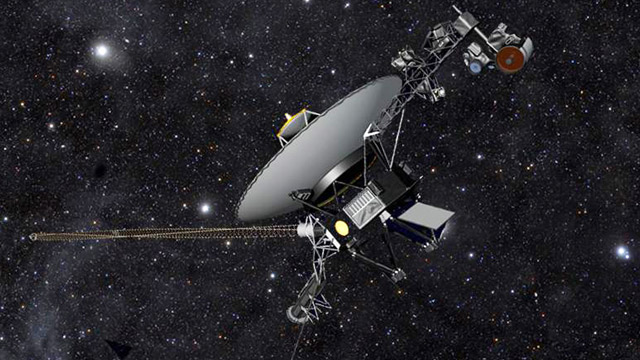Science
Related: About this forumCheers to 40 Years! Voyagers 1 and 2 going strong
It's been 40 years to the day since the Voyager mission commenced with the launch of Voyager 1.
This groundbreaking and incredibly ambitious mission touched on practically every aspect of our solar system and planetary neighbors.
Voyager 1 left Earth on September 5, 1977 - preceded by Voyager 2 on August 20th - on a quest to study the outer solar system. Today NASA and the Smithsonian National Air and Space Museum are celebrating the 40th anniversary of this history-making mission.
Throughout the 1960s, NASA had focused on sending astronauts to the Moon. But by the 1970s, as the Apollo era ended, the agency's focus shifted toward robotic missions to the planets, as well as developing the Space Shuttle program for delivering payloads to Earth orbit.
In 1964, with Apollo 11's landing still a half decade away, Caltech graduate student and Jet Propulsion Laboratory intern Gary Flandro was working to develop feasible trajectories for a mission to the outer planets. He turned his attention to the relatively new idea of gravity assist, whereby a spacecraft passing close by a planet steals some of its orbital speed, accelerating without expending any rocket fuel.
Flandro's pencil-and-paper plots of the outer planets revealed that Jupiter, Saturn, Uranus, and Neptune would align in the late 1970s such that one spacecraft could visit all four in a single mission if it launched by 1977.
The craft would slingshot around each planet in succession, completing a "Grand Tour" in only 10 to 12 years. By comparison, sending a dedicated spacecraft to only Neptune would take 40 years without passing any other planets along the way.
At: http://www.skyandtelescope.com/astronomy-news/cheers-to-40-years-voyager-1-and-2-going-strong/
Voyager 1: going strong at 40 years.
Warpy
(111,256 posts)and that will be a sad day at NASA.
A few eons from now, they might approach another star system and start transmitting again. I wonder who or what will be out there to hear it.
They were amazingly engineered.
lordsummerisle
(4,651 posts)which I guess won't last for eons.
https://en.wikipedia.org/wiki/Voyager_1
longship
(40,416 posts)Powered by Plutonium 238.
Radioisotope thermoelectric generator will provide power up to another decade. That depends on how much power these spacecraft can save by shutting things off. They've already done quite a bit of that. Very few systems are still operating. Nevertheless, the deep sky network is still in daily contact. The last systems that will have power will undoubtedly be the radio transmitters and receivers.
No batteries necessary.
NNadir
(33,517 posts)...the only constraint on its lifetime.
The strength of the radio signal decreases with the square of the distance. This is the biggest limitation on how long we'll be able to hear from the spacecraft. Having the radio operate when no on board devices can operate doesn't make any sense.
The radioactive decay of Pu-238 doesn't really account for all that much of the lifetime of the device. The RTG will be putting out power for more than a century, reliably, but not enough to transmit across the increasing distances. (A tiny amount of power is generated by the Pu-238 decay products, probably mostly Th-230 and Ra-226, even less from U-234.)
Interestingly, the deeper into space the spacecraft go, the more efficient the energy conversion from heat to electricity becomes, since in many ways a thermoelectric device has similar thermodynamics to other types of (mechanical) heat engines, and depends on the temperature difference between the heat source and the heat sink. It is about as cold as one can get where the craft are now.
(I have a post on the topic of thermoelectric devices - maybe too long for this forum - in prep; I've recently been studying the materials chemistry of novel high ZT thermoelectric materials.) It does seem that it may at some point be possible, to the extent we can manufacture nanostructured materials with high reliability, to build devices that are far more efficient than mechanical devices. This was nowhere near the case in 1977. The thermodynamic efficiency of the RTG was on the order of 5 or 6%, whereas a typical Rankine cycle device operates at around 30%, or when in tandem with a Brayton device, above 50%.
longship
(40,416 posts)lordsummerisle
(4,651 posts)and these probes were designed and built back when most of the computers around were large mainframes that had the processing power that was less than that of the first desktop computers in the 80's.
I also remember reading a technical article about receiving the signals from the Voyagers. They are so far away that the signals when they are received are only a few billionths of a watt and a ton of processing is needed to tease out the signal from all of the background noise.
central scrutinizer
(11,648 posts)[link:https://m.
|lastlib
(23,226 posts)Warren DeMontague
(80,708 posts)IMHO. ![]()
sandensea
(21,635 posts)And why not? It's changed in so many other ways.

Columbus Circle in the 1980s.

And today.
Rhiannon12866
(205,320 posts)Voyager is amazing and fascinating, thanks so much for posting this! BTW, I have President Carter's autobiography and he follows the exploits of Voyager, too! ![]()
![]()
sandensea
(21,635 posts)Carter, as you know, was very supportive of the space program - and largely reversed the steep cuts to NASA and the JPL under Nixon and Ford.
I always thought it unfortunate that the launching of the space shuttle Columbia was delayed until April 1981.
Had they been able to launch it in 1980 as was planned, it would have, of course, taken place under his watch - and would have no doubt been a very nice memory for him in a year Carter himself described as "the most difficult of my life."
But in life and in politics, timing doesn't always cooperate.
littlemissmartypants
(22,656 posts)Thanks, sandensea.
♡lmsp
